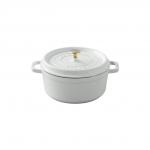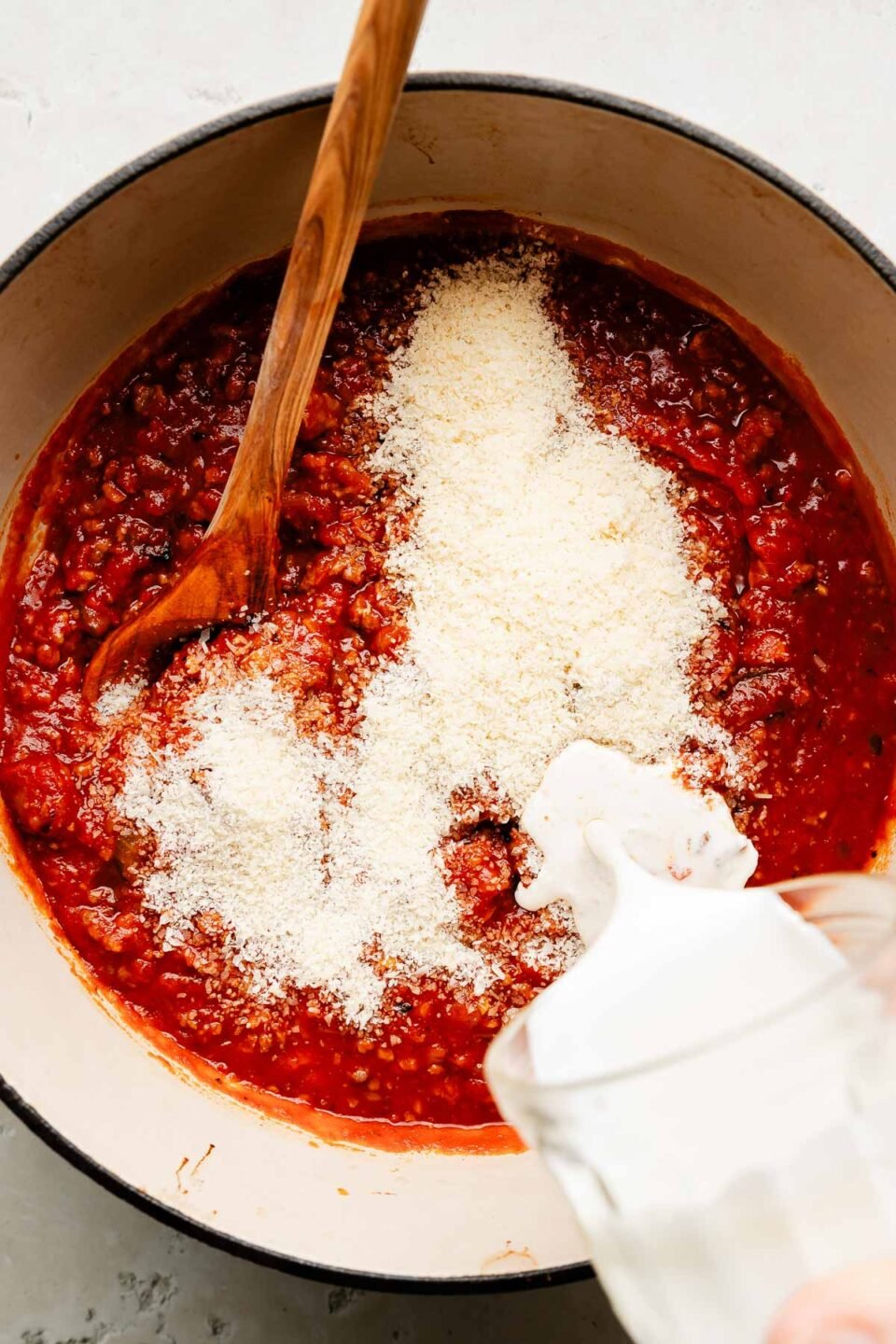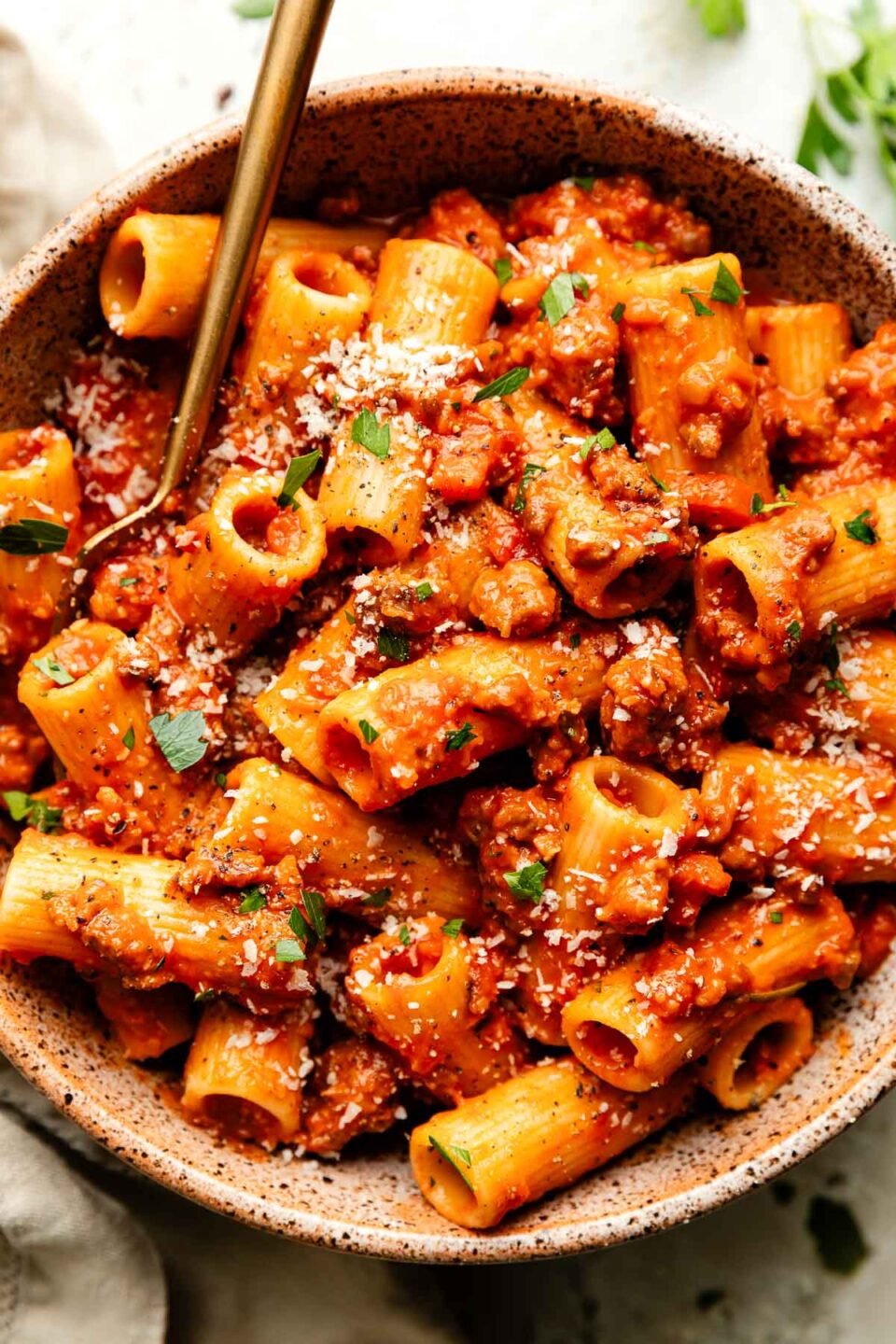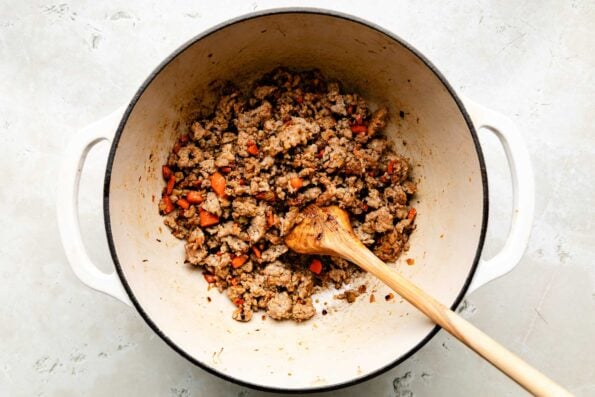Sweet and Spicy Italian Sausage Makes the Best Bold and Hearty Ragu Sauce!
I was first introduced to the delicious world of ragu when I worked in a fine-dining Italian restaurant in Milwaukee. Our house specialty was ragu della casa, a slowly simmered, scratch-made ragu sauce tossed with hand-cut pappardelle. I loved this pasta dish just as much as our guests did, and so I begged Chef to teach me how to make it in hopes that I could recreate it for dinner at home.
10+ years later, ragu is one of my all-time favorite dishes to make (and eat! 😋). Over the years, we’ve shared a pretty extensive collection of Italian-style ragu recipes here on PWWB, everything from Slowly Braised Beef Ragu to Tender Shredded Pork Ragu, and even Hearty Wild Mushroom Ragu. Today, we add Sweet and Spicy Italian Sausage Ragu to the list!
Boldly spiced Italian sausage slowly simmers with aromatic vegetables, garlic, fresh herbs, tomatoes, and white wine, creating a hearty sauce with incredible depth of flavor. The natural richness of pork sausage gives the ragu an especially luscious texture, while its seasonings lace the sauce with the fragrant notes of fennel seed and red pepper.
The best part is the stove does all of the work, coaxing all of the flavor out of the ingredients over the course of an hours-long simmer. All that’s left to do is toss the sausage ragu sauce with pasta and enjoy! Simple, scrumptious comfort food at its finest!
If you love cooking with Italian sausage, be sure to try my Spicy Sausage and Peppers Pasta or Creamy Marsala Pasta with Sausage, two easy pasta dinners that are loaded with bold flavor and don’t require slow simmering (ready in 35 minutes!).


FREE Email Series: PWWB Pasta School
Make restaurant-worthy pasta at home!
Quick Recipe Background ⇢ What is Ragu?
Ragu is a term used to describe a rich, slowly simmered Italian meat sauce traditionally served with pasta, gnocchi, or polenta. (I’m willing to bet you’re already familiar with one of the most famous ragu sauces, Ragu alla Bolognese!) Since ragu is meant to showcase a specific meat, it’s a bit more stew-like than other famous Italian pasta sauces like marinara.
You can prepare ragu sauce using many types of meat (or meaty vegetables), creating anything from Succulent Beef Short Rib Ragu to Tender Shredded Chicken Ragu. The common thread is that ragu is always super hearty with rich, bold flavor.
If you’ve never made ragu before, you’re in great hands! Ever since my restaurant days, I’ve cooked up 10+ years of experience making this dish and have plenty of tips and tricks to help you along the way. Read on to learn more about how to make this Slowly Simmered Sausage Ragù, or jump straight to the recipe and get cooking!
Key Ingredients

Note: Full ingredients list and measurements provided in the Recipe Card, below.
Best sausage to use? ⇢ For a boldly flavored Italian sausage ragu sauce, pork sausage works best. Full-fat sausage holds up over a long simmer and its natural richness gives the sauce beautifully luscious texture. Throughout recipe testing, I also grew partial to using a combination of mild and spicy sausage. The sweet spices of mild sausage lace the sauce with aromatic flavor, while the red pepper in spicy sausage creates a nice, lingering heat that isn’t overwhelmingly spicy.
A few more things to keep in mind…
- Bulk sausage vs links: If you can’t find bulk ground sausage, feel free to buy fresh sausage links and remove the casing before cooking.
- Leaner sausage varieties: If you prefer to use chicken or turkey Italian sausage, be sure to reduce the simmer time so the meat doesn’t dry out. Check the Recipe Notes, below, for more guidance.
Other key ingredients:
- Soffritto – The Italian holy trinity of carrot, celery, and onion. I like chopping these base veggies into chunky pieces for a more rustic texture, but you can also blitz them in a food processor to make prep quick and simple.
- Aromatics – Plenty of garlic, fresh herbs like rosemary and thyme, and dried bay leaves create a boldly flavored sauce. My secret ingredient is a parmesan rind, which infuses the spicy sausage ragu with rich, umami flavor.
- Wine – Many of my ragu recipes use red wine, but I’ve opted for white wine for this sausage ragu. It adds a lot of brightness without competing with the rich sausage, allowing the meat to shine. A dry, unoaked variety like Pinot Grigio works best.
Shop This Post

DeLallo Extra Virgin Olive Oil
Buy Now → Buy Now →
Buy Now → 
Staub Enameled Cast Iron Round Dutch Oven
Buy Now → Buy Now →
Buy Now →  Buy Now →
Buy Now → 
Stainless Steel Measuring Cups & Spoons
Buy Now → Buy Now →
Buy Now →  Buy Now →
Buy Now → How to Make Sausage Ragu Sauce
There are 3 main steps to making a restaurant-worthy ragu sauce: browning, deglazing, and simmering. While there is a little prep involved, most of the cooking time is entirely hands-off while the sauce bubbles on the stovetop and develops rich flavor. Patience is key here – the results are so worth it!


Full Recipe Directions, including step-by-step photos, are included in the Recipe Card, below.
Brown the soffritto. Cook the carrots, celery, and onion in a heavy-bottomed pot, like a Dutch oven, until deeply browned and nearly caramelized. This takes 15-20 minutes and cannot be rushed! Why so long?! ⇢ These aromatics create the base of flavor for the entire sauce. Browning them well coaxes out all of their flavor and leaves a delicious fond of browned bits on the bottom of the pot. Trust me, this single step creates the difference between an average sauce and a restaurant-worthy sausage ragu.
Brown the Italian sausage. Add the sausage to the pot. Allow it to brown well, then crumble it into bite-sized pieces. Why? ⇢ In short, FLAVOR! Thanks to a chemical process called the Maillard reaction, the sausage’s rich flavor deepens as it browns.
Deglaze the pot. Stir in the tomato paste and garlic, coating the browned soffritto and sausage mixture, then slowly pour in the white wine. The liquid will instantly simmer and create steam that releases the browned fond from the bottom of the pot. Use a wooden spoon to scrape it up, then let the wine reduce and absorb into the meat and veggies. Why? ⇢ The combination of richly browned fond and bright wine layers TONS of flavor into the base of the sauce.


Full Recipe Directions, including step-by-step photos, are included in the Recipe Card, below.
Build the sausage ragu sauce. Add the tomatoes, fresh herbs, dried bay leaves, parmesan rind, and chicken stock to the pot, stirring to combine well. Quick prep tip! ⇢ Rather than picking and chopping the fresh herbs, use kitchen twine to tie the whole sprigs together.
Simmer. Simply step away and let the Italian sausage ragu slowly simmer on the stovetop for about 90 minutes. Why? ⇢ A long simmer allows all of the flavors to meld together and create a boldly flavored sauce.
Alternate Cooking Methods
I love cooking ragu with a low and slow stovetop simmer, but you can also prepare this sausage ragu recipe in the oven, a slow cooker or Crockpot, or an electric pressure cooker like the Instant Pot. Check the Recipe Notes, below, for step-by-step guidance!
Serving Suggestions – Pasta, Polenta, and More!
There’s nothing better than serving a hearty, comforting ragu with a pile of cozy carbs – a match made in heaven!
Best pasta for sausage ragu? ⇢ Italian ragu is traditionally served with a wide and flat pasta like pappardelle or tagliatelle. That said, I love serving this sausage ragu sauce with a short, tube-shaped pasta like paccheri, penne, or rigatoni (pictured). Its chunky bits and pieces get trapped through the center of the noodle, giving you even more texture and flavor in each bite. 😋


How to Make Sausage Ragu Pasta
The #1 mistake I see home cooks make when preparing a pasta dish is simply plopping a spoonful of sausage ragu sauce on a plate of cooked pasta. Please don’t do this! For restaurant-worthy results, always simmer your al dente pasta with the ragu sauce before serving. To learn more, check out my complete guide for How to Cook Pasta Perfectly Every Single Time.
Boil the pasta. Generously season a large pot of water with salt, then bring it to a boil. Add your pasta of choice and cook to al dente. Be sure to save some starchy pasta water before draining!
Finish the sausage ragu sauce. While the pasta boils, stir a splash of heavy cream and a handful of grated parmesan cheese into the sausage ragu. Why? ⇢ Heavy cream rounds out the intensity of the sauce, while parmesan tightens it up with a punch of umami flavor.
Simmer with pasta. Add the al dente pasta to the pot of sausage ragu, tossing well so the pasta is evenly coated in sauce. Adjust as needed! ⇢ Loosen everything up with a splash of reserved pasta water or tighten up the sauce with an extra handful of parmesan. At this point, you can also taste and adjust seasonings as needed.

Make-Ahead, Storage and Freezing
Italian sausage ragu stores super well – in fact, its flavors only get better the longer it sits! Feel free to prep a batch of sauce ahead of time. It will keep in the refrigerator for up to 5 days or in the freezer for up to 3 months. Check the Recipe Notes, below, for step-by-step guidance!

I can’t wait for you to try this Slowly Simmered Sausage Ragu! I’m obsessed with its bold sweet and spicy flavor, and I think you will love it too.
If you do give it a try, be sure to let us know! Leave a comment with a star rating below. You can also snap a photo and tag @playswellwithbutter on Instagram. We LOVE seeing your PWWB creations! ♡ Happy cooking!
Print
Slowly Simmered Italian Sausage Ragu (Stovetop, Slow Cooker, Instant Pot)
- Prep Time: 20 minutes
- Cook Time: 2 hours 10 minutes
- Total Time: 2 hours 30 minutes
- Yield: serves 8–10 1x
- Category: Pasta Recipes, Main Dish
- Method: Stovetop
- Cuisine: Italian
Description
“Ragu” is a term used to describe a rich, slowly cooked Italian meat sauce. It’s hearty, intensely flavorful, and, unlike a slowly simmered marinara or tomato sauce, ragu is all about the meat (or a meaty ingredient, like mushrooms!).
I learned how to cook ragu 10+ years ago, working at a fine dining Northern Italian restaurant. To this day, it’s one of my favorite things to cook! We’ve shared many ragu recipes over the years here on PWWB, and today we’re adding this Slowly Simmered Italian Sausage Ragu to the collection.
Slowly simmering Italian sausage with aromatic vegetables, fresh herbs, tomatoes, and white wine coaxes out all of its flavor, creating a succulent sauce that’s laced with fennel and spices from the sausage. Simply toss into pasta (or serve with another cozy carb like gnocchi or polenta) and it’s a decadent, comforting, and totally restaurant-worthy dinner!
To learn all about ragu, be sure to check out the blog post, above, and for alternate cooking methods, like Instant Pot or slow cooker sausage ragu, check out the Recipe Notes, below. ♡ Happy cooking!
Ingredients
for the Italian sausage ragu sauce:
- 1 ½ pounds fresh Italian sausage of choice (see Recipe Notes)
- 3 large carrots, diced
- 1 large yellow onion, diced
- 1 stalk celery, diced
- 8 cloves garlic, finely chopped or grated
- 2 tablespoons olive oil
- one 6-ounce can tomato paste
- 1 cup dry, unoaked white wine, such as Pinot Grigio
- one 28-ounce can crushed tomatoes
- 2 sprigs fresh rosemary
- 8–10 sprigs fresh thyme
- 2 dried bay leaves
- optional: 1 parmesan rind
- 2 cups chicken stock or water
- kosher salt and ground black pepper, to season
for sausage ragu pasta:
- 16 ounces rigatoni or pasta of choice
- ½ cup heavy cream
- ½ cup grated parmesan or pecorino romano cheese
- for serving, as desired: grated parmesan, finely chopped fresh herbs, etc.
Instructions
- Brown the soffritto: Add the olive oil to a Dutch oven (or large, heavy-bottomed pot with lid, at least 4-qt capacity) over medium-high heat. Once the oil is hot and shimmering, add the carrots, celery, and onion. Season with 1 ½ teaspoons kosher salt, and stir to combine. Cook, stirring occasionally, until deeply browned and fragrant, 15-20 minutes. If the veggies begin to brown too quickly, reduce the heat to medium or medium-low. Once browned, push the soffritto mixture to the outer edges of the pot.
- Brown the Italian sausage: Add the Italian sausage to the center of the pot, such that it’s surrounded by the soffritto mixture. Reduce heat to medium. Let the sausage brown 2-3 minutes without touching it, then turn it over and brown the second side 2-3 minutes before using a wooden spoon to break it apart into bite-sized pieces. Stir to combine with the soffritto mixture.
- Add aromatics and deglaze: Add the garlic and tomato paste to the Dutch oven, stirring to coat the Italian sausage soffritto mixture. Cook 2-3 minutes, until browned and fragrant. Deglaze the pot by slowly pouring in the white wine, using a wooden spoon to scrape up any browned bits that may have formed on the bottom of the pan. Let the wine simmer until it’s almost cooked off.
- Build the Italian sausage ragu sauce: Tie the fresh herbs together using kitchen twine (or finely chop if you do not have twine), then add to the pot with the crushed tomatoes, fresh rosemary and thyme, bay leaves, parmesan rind (if using), and chicken stock or water (I start with about 1 cup of stock/water, then add more as needed as the sauce simmers). Stir to combine well.
- Simmer the Italian sausage ragu sauce: Bring the sausage ragu sauce to a boil, then reduce heat to medium-low to maintain a very gentle simmer. Partially cover the pot (place the lid on the pot such that it’s just partially covered, allowing some steam to escape as the sauce simmers). Simmer the Italian sausage ragu sauce 90 minutes, stirring occasionally. If the sausage ragu sauce begins to reduce too much (losing too much of its liquid too quickly), feel free to add in a splash more broth/water and reduce the heat further. Once the sauce is simmered, remove and discard the spent herbs, bay leaves, and parmesan rind from the pot. Use At this point, you can cool and store for later use (see Recipe Notes for storage and freezing directions), or proceed with making the sausage ragu pasta (below).
Sausage Ragu Pasta:
- Boil the pasta: About 20 minutes before the Italian sausage ragu sauce is ready, begin cooking the pasta. Bring a large pot of salted water to a boil. Once boiling, add the rigatoni and cook to al dente according to package directions, stirring occasionally to prevent sticking. Once cooked, carefully dip a liquid measuring cup into the pot to reserve about 1 cup of the starchy pasta water, and set aside. Carefully drain the pasta. (Learn more! ⇢ How to Cook Pasta Perfectly Every Single Time!)
- Finish the sausage ragu pasta: Meanwhile, as the pasta boils, bring the slowly simmered Italian sausage ragu sauce up to a simmer. Stir in the heavy cream and parmesan cheese. Add the cooked rigatoni to the pot with the sausage ragu sauce, tossing to combine. The sausage ragu should evenly coat the pasta. Add in some of the reserved pasta water if the sauce needs to loosen up a little; add in an extra handful of parmesan if it needs to tighten up a little. Cook over medium heat for 1-2 minutes, allowing the pasta to meld with and absorb some of the sausage ragu.
- Serve: Portion the Italian sausage ragu pasta into individual pasta bowls, topping with additional grated parmesan, chopped fresh herbs, and/or crushed red pepper as desired. Serve immediately. Enjoy!
Notes
- Jess’ Tips and Tricks:
- Best sausage to use for Italian sausage ragu: This recipe was tested and developed using a full-fat pork Italian sausage. I love using a blend of half spicy Italian sausage and half mild/sweet Italian sausage (i.e. ¾ pound each) – I find that it creates the perfect amount of lingering heat without overwhelming the sauce. Please feel free to adjust based on your preferences and spice tolerance! If you cannot find bulk sausage, feel free to buy sausage links and cut the sausage meat out of the casing. If you prefer to use a leaner sausage, like turkey Italian sausage, plan to reduce simmer time to 20-30 minutes, tops.
- Best pasta for sausage ragu: I love serving this sausage ragu sauce with rigatoni (pictured), a tubular short pasta with ridges. The sausage ragu sauce really clings to the ridges of the pasta beautifully, while little bits of sausage get caught inside the pasta, making each bite even more flavorful! That said, you can prepare this sausage ragu using whatever pasta you love best. If you like long pasta, spaghetti, bucatini, and tagliatelle are all delicious options. For the ultimate cozy dinner, pair your sausage ragu with gnocchi or polenta.
- 10-Minute Meal Prep: Nearly all of the active prep work for this sausage ragu recipe comes from prepping the veggies. Take care of this in advance – it takes 10 minutes, tops! – and you can jump straight in to cooking during the week: dice 3 medium carrots, 1 stalk of celery, and 1 large yellow onion. Transfer to an airtight container and store in the refrigerator for up to 5 days. (10 minutes active)
- Storage and Reheating:
- Sausage Ragu Pasta Storage and Reheating: Leftover sausage ragu pasta will keep, stored in an airtight container in the refrigerator, for 3-4 days. Reheat in the microwave or on the stovetop until warmed through, adding a splash of stock or water as needed to loosen up the sausage ragu sauce to your desired texture.
- Make-Ahead Italian Sausage Ragu Sauce Storage and Reheating: This sausage ragu sauce is the perfect make-ahead recipe because it stores so well – it’s one of those things that gets even better as it sits and its flavors meld together! To store, prep the sauce through Step 6 of Recipe Directions, above. Once cooled, transfer to an airtight container and store in the refrigerator for up to 5 days. Reheat sausage ragu sauce on the stovetop. Once simmering, finish according to “Sausage Ragu Pasta” Steps 1-3 of Recipe Directions, above.
- Sausage Ragu Sauce Freezer Instructions:
- Sausage ragu is also incredibly freezer-friendly. To freeze, transfer the cooled sausage ragu sauce to a freezer container or divide between multiple freezer containers for smaller portions – Souper Cubes are my absolute favorite freezer containers! Freeze up to 3 months. To thaw, place the frozen sausage ragu in the refrigerator overnight or submerge the freezer container in room temperature water for a quicker thaw. Reheat the ragu sauce in a skillet. If the thawed ragu sauce is a little watery at first, simply allow any residual water simmer out. If the thawed ragu sauce is too thick, simply add in a splash of water or stock until your desired consistency is reached. Once simmering, finish according to “Sausage Ragu Pasta” Steps 1-3 of Recipe Directions, above.
- Alternate Cooking Methods:
- Oven Braised Sausage Ragu: Prep the sausage ragu sauce according to Steps 1-5, above. Rather than simmering on the stovetop, transfer the covered pot to a 325 degree F oven. Slowly cook in the oven for 90 minutes or until the sausage ragu sauce is thickened slightly. Finish the sausage ragu sauce as directed in Step 6 and complete the recipe according to “Sausage Ragu Pasta” Steps 1-3.
- Crock Pot / Slow Cooker Sausage Ragu: Prep the recipe according to Steps 1-4, above. Transfer the soffritto mixture to the slow cooker, along with the aromatics, tomatoes, and broth/stock (or water). Slow cook on high for 2-3 hours or on low for 4-5 hours, stirring occasionally. Finish the sausage ragu sauce as directed in Step 6 and complete the recipe according to “Sausage Ragu Pasta” Steps 1-3 – you can combine the sauce and pasta right in your slow cooker. If your slow cooker has a searing/browning feature, you can use it to cook the entire Italian sausage ragu sauce recipe (Steps 1-6) in the slow cooker.
- Electric Pressure Cooker / Instant Pot Sausage Ragu: Use your Instant Pot’s “Sauté” setting to cook the recipe according to Steps 1-5, above. Cover and seal the pressure cooker and cook on manual high pressure for 35 minutes. Allow the pressure cooker to naturally release pressure for 10 minutes before carefully flicking the valve to its “venting” position to vent out any residual pressure. If the ragu seems a little too liquidy, feel free to turn on the Sauté setting again, letting the sauce simmer down a little before finishing as directed in Steps 6. Complete the recipe according to “Sausage Ragu Pasta” Steps 1-3 – you can combine the sauce and pasta right in your Instant Pot.
Recipe and Food Styling by Jess Larson, Plays Well With Butter | Photography by Rachel Cook, Half Acre House.

Follow along with Plays Well With Butter on Instagram, YouTube, Facebook, and Pinterest for more unfussy recipes that pack a big punch of flavor!






















